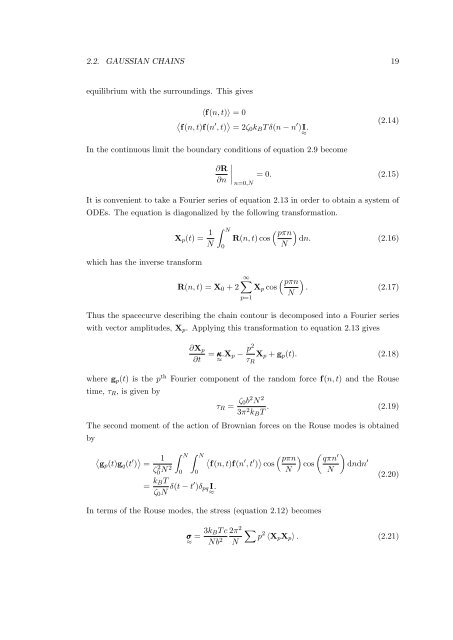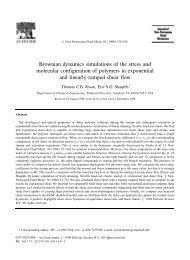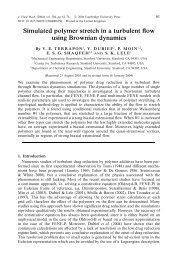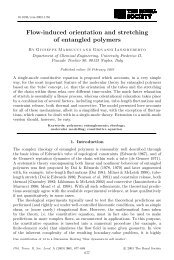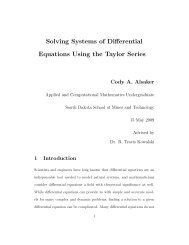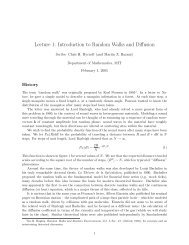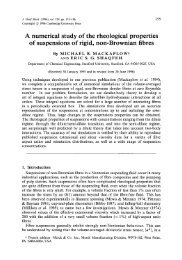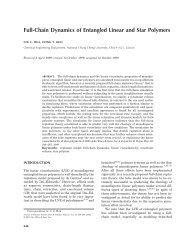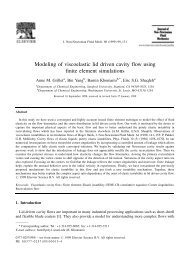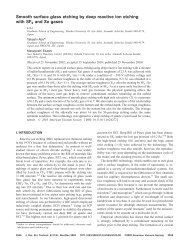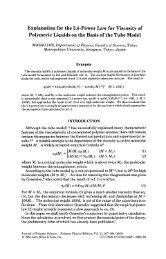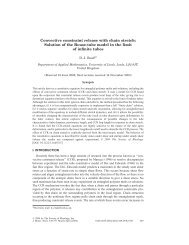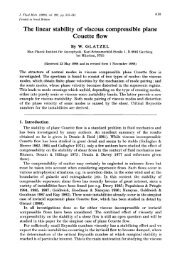Molecular modelling of entangled polymer fluids under flow The ...
Molecular modelling of entangled polymer fluids under flow The ...
Molecular modelling of entangled polymer fluids under flow The ...
Create successful ePaper yourself
Turn your PDF publications into a flip-book with our unique Google optimized e-Paper software.
2.2. GAUSSIAN CHAINS 19<br />
equilibrium with the surroundings. This gives<br />
〈f(n, t)〉 = 0<br />
〈<br />
f(n, t)f(n ′ , t) 〉 = 2ζ 0 k B T δ(n − n ′ )I<br />
≈<br />
.<br />
(2.14)<br />
In the continuous limit the boundary conditions <strong>of</strong> equation 2.9 become<br />
∂R<br />
∂n<br />
⏐ = 0. (2.15)<br />
n=0,N<br />
It is convenient to take a Fourier series <strong>of</strong> equation 2.13 in order to obtain a system <strong>of</strong><br />
ODEs. <strong>The</strong> equation is diagonalized by the following transformation.<br />
X p (t) = 1 N<br />
∫ N<br />
0<br />
R(n, t) cos<br />
( pπn<br />
)<br />
dn. (2.16)<br />
N<br />
which has the inverse transform<br />
R(n, t) = X 0 + 2<br />
∞∑ ( pπn<br />
)<br />
X p cos . (2.17)<br />
N<br />
p=1<br />
Thus the spacecurve describing the chain contour is decomposed into a Fourier series<br />
with vector amplitudes, X p . Applying this transformation to equation 2.13 gives<br />
∂X p<br />
∂t<br />
= κ<br />
≈<br />
.X p − p2<br />
τ R<br />
X p + g p (t). (2.18)<br />
where g p (t) is the p th Fourier component <strong>of</strong> the random force f(n, t) and the Rouse<br />
time, τ R , is given by<br />
τ R = ζ 0b 2 N 2<br />
3π 2 k B T . (2.19)<br />
<strong>The</strong> second moment <strong>of</strong> the action <strong>of</strong> Brownian forces on the Rouse modes is obtained<br />
by<br />
〈<br />
gp (t)g q (t ′ ) 〉 = 1<br />
ζ 2 0 N 2 ∫ N<br />
0<br />
∫ N<br />
= k BT<br />
ζ 0 N δ(t − t′ )δ pq I<br />
≈<br />
.<br />
0<br />
〈<br />
f(n, t)f(n ′ , t ′ ) 〉 ( pπn<br />
)<br />
cos cos<br />
N<br />
In terms <strong>of</strong> the Rouse modes, the stress (equation 2.12) becomes<br />
( qπn<br />
′<br />
N<br />
)<br />
dndn ′<br />
(2.20)<br />
σ = 3k BT c 2π 2 ∑<br />
p 2<br />
≈ Nb 2 〈X p X p 〉 . (2.21)<br />
N


